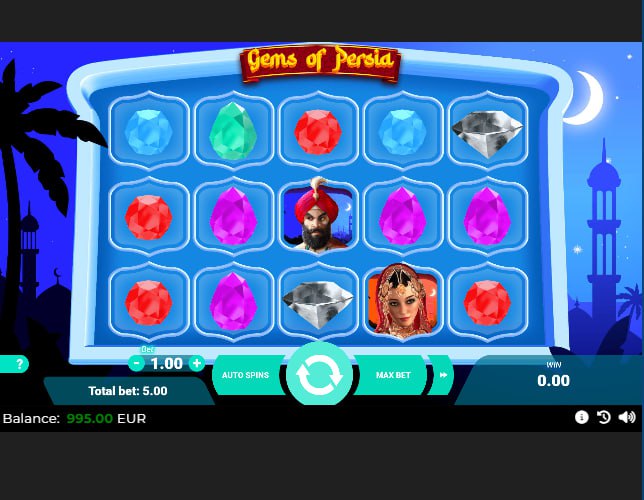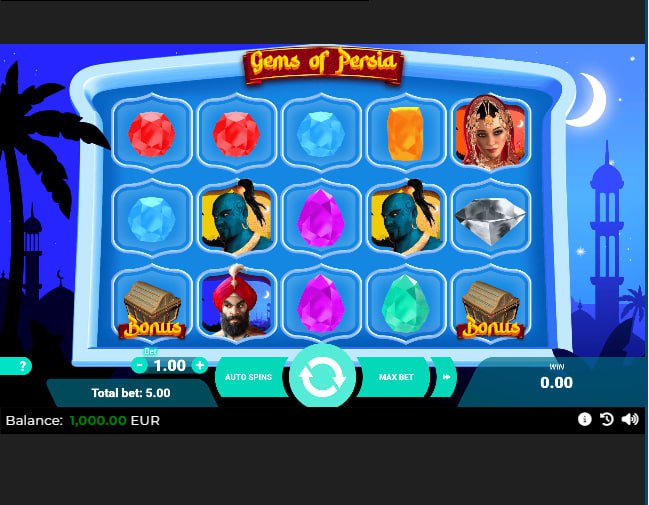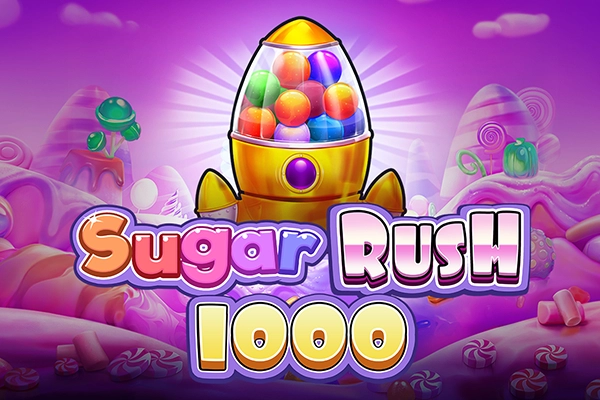Gems of Persia by Consulabs presents a clean, illustrative interpretation of the Arabian treasure theme. The game’s atmosphere is defined by a stylized nighttime cityscape, which prioritizes visual clarity over complex animated sequences. It operates on a 5×3 reel structure and uses a 243-ways-to-win system, where wins are formed by adjacent symbols from left to right. A notable design choice separates the function of its special symbols; the Scatter provides direct bet multipliers while a distinct Bonus symbol is the key to the main feature. The primary Bonus Feature activates when Treasure Chest symbols land simultaneously on the first and last reels. This trigger initiates an interactive, multi-stage pick-and-click game where players must locate a hidden treasure. Success in this sequence awards a variable number of free spins combined with a win multiplier. The overall design favors straightforward mechanics and a structured feature unlock over a complex narrative.
Consulabs presents Gems of Persia, a video slot that approaches the familiar Arabian Nights theme with a focus on mechanical clarity and a structured bonus sequence. Rather than relying on ornate, complex visuals, the game utilizes a clean, almost illustrative art style. Its core appeal is built upon two foundational pillars: the 243-ways-to-win system and a multi-stage, interactive bonus game that diverges from the common “three scatters trigger free spins” model. This design philosophy suggests a target audience of players who value straightforward mechanics and the anticipation built through sequential feature unlocks.
The game bypasses common tropes by separating the functions of its special symbols. A Scatter symbol exists purely for direct monetary reward, while a distinct Bonus symbol serves as the sole key to the main feature. This separation creates two different points of excitement during base gameplay. The visual presentation is bright and functional, framing the gameplay within a stylized depiction of a Persian city at night. This choice puts the spotlight firmly on the reel mechanics and the symbol interactions, making it an interesting case study in slot design where gameplay structure is given precedence over immersive, narrative-driven presentation.

Unlocking the Bonus Game and Scatter Payouts
The primary feature in Gems of Persia is a multi-layered bonus game that requires a specific and less common trigger. Instead of landing a number of symbols anywhere in view, players must land the Treasure Chest Bonus symbol on both reel 1 and reel 5 in the same spin. This specific requirement changes the dynamic of the base game. The player's attention is constantly drawn to the outer reels, creating a distinct form of anticipation. A near-miss, where a Bonus symbol lands on reel 1 but not reel 5 (or vice versa), feels different from missing a third scatter in a more conventional slot. This design choice makes the trigger event feel more deliberate and significant when it occurs.
Once triggered, the bonus is not an immediate transition to free spins. Instead, it unfolds as a three-stage pick-and-click sequence.
The first screen presents a grid of keys, and the player must select one. The interface does not explicitly state if this choice impacts the outcome, which introduces a small element of mystery. It could be a purely cosmetic step to enhance the theme of unlocking a treasure, or it could subtly influence the possibilities in the next stage.
The second stage reveals six treasure chests. The objective is to find the “main treasure” within three attempts. This phase is the core of the interactive element. With a 50% chance of success over three picks (assuming the treasure is in one chest), this stage introduces a meaningful risk/reward calculation. Successfully finding the treasure advances the player to the final reward stage. Failure at this point likely results in a smaller consolation prize, ending the feature prematurely. This structure effectively builds tension, as the entire potential of the free spins round hinges on these three picks.
Upon successfully locating the treasure in stage two, the final stage reveals the reward: a set number of free spins combined with a win multiplier. The game’s help screen indicates this can be up to 10 free spins and up to a x2 multiplier. This variability means that even triggering the bonus does not guarantee a uniform outcome. The reward itself is determined by an element of chance within the feature, adding another layer of unpredictability.
Separate from this entire sequence is the Scatter symbol, represented by a golden, jewel-encrusted ornament. Its function is refreshingly direct: it acts as a total bet multiplier. Landing 3, 4, or 5 Scatters anywhere on the reels results in an instant payout of 5x, 10x, or 50x the total stake, respectively. This symbol does not trigger any features or free spins. This decision to divorce the Scatter's role from the main bonus trigger is a noteworthy design choice. It allows for two independent high-value events during the base game: the potential for a large instant win from the Scatters, and the chance to unlock the multi-stage bonus via the Chest symbols. It provides a more varied gameplay experience compared to slots where a single symbol serves both functions.
Visual Craftsmanship and Thematic Execution
Gems of Persia employs a distinct visual style that favors clarity and bold colors over photorealism or intricate detail. The aesthetic can be described as modern digital illustration, utilizing solid colors, clean lines, and high-contrast elements. The background depicts a silhouetted cityscape of minarets and domed buildings against a deep blue and purple night sky, punctuated by a crescent moon. This backdrop is static and serves as an atmospheric frame rather than an active part of the game, ensuring that the player's focus remains squarely on the reels. The reel frame itself is a stylized blue archway, reinforcing the Persian architectural theme in a simple, effective manner.
The symbol design follows this same philosophy. The high-value symbols are character icons: a Princess, a man in a turban, and a blue-skinned genie-like figure. They are drawn in a clean, characterful style that makes them instantly recognizable. The mid-tier symbols, a magic lamp and a diamond, and the low-tier colored gemstones, are rendered with sharp edges and a glossy finish that makes them pop against the dark background. There are no subtle textures or complex shading; the goal is immediate legibility. This approach is highly effective on smaller screens and for players who prefer an uncluttered visual experience.
When a winning combination occurs, the animations are functional and direct. The winning symbols are highlighted, and a line may briefly animate to show the connection, but there are no lengthy cinematic sequences. The sound design complements this, with standard reel-spinning sounds and distinct chimes for wins. The most significant audio-visual feedback is reserved for the triggering of the bonus game, signaling a clear shift from the base game to the feature. The overall presentation is polished and professional, if somewhat conservative. It is a game designed for gameplay efficiency, where the art serves the mechanics rather than overshadowing them. This makes the experience feel less like a narrative journey and more like a well-structured game machine.
Deconstructing the 243 Ways to Win Engine
At its mechanical heart, Gems of Persia operates on a 243-ways-to-win engine. This system eschews traditional paylines in favor of a more fluid winning condition. A win is awarded for landing three or more matching symbols on adjacent reels, starting from the leftmost reel (reel 1). The specific vertical position of the symbols on each reel is irrelevant, as long as they appear on consecutive reels. For example, a Princess symbol on any position of reel 1, another on any position of reel 2, and a third on any position of reel 3 constitutes a three-of-a-kind win. This mechanic significantly increases the number of potential winning combinations compared to a fixed-payline slot, often resulting in a higher frequency of smaller wins.

The paytable is structured to work in concert with this engine. There is a steep drop-off in value from the highest-paying symbol to the rest. The Princess symbol awards 1000 credits for a five-of-a-kind combination, while the next highest symbol, the Turbaned Man, awards 400. This makes a full five-symbol combination of the Princess a major game event, creating a high-volatility spike within the paytable. The lower-value gemstone symbols offer much flatter payouts, designed to provide the more frequent, smaller wins that are characteristic of 243-ways systems. This structure creates a dynamic where players are sustained by small wins while hoping for the infrequent but highly valuable five-of-a-kind character combinations. The interaction between the high-value symbols and the 243-ways system can produce complex payout calculations. If the payout logic for multiple combinations seems unclear, one can launch the Gems of Persia demo and consult the integrated game guide, typically accessed via an “i” or “?” button, for a complete breakdown of the rules.
This mechanical foundation has a direct impact on the player experience. There is no need to memorize payline patterns; the focus shifts entirely to the left-to-right flow of symbols. The game becomes a visual exercise in spotting matching icons on adjacent reels. The presence of the 243-ways system also gives added weight to the free spins multiplier. Even a seemingly modest x2 multiplier can have a substantial effect when applied to the multitude of potential winning combinations that this engine can generate in a single spin. It's a solid, proven mechanic that, when combined with the game's other features, provides a reliable and easy-to-understand gameplay loop. The game's design is a testament to the idea that a few well-executed mechanics can be more engaging than a multitude of overly complex ones.













